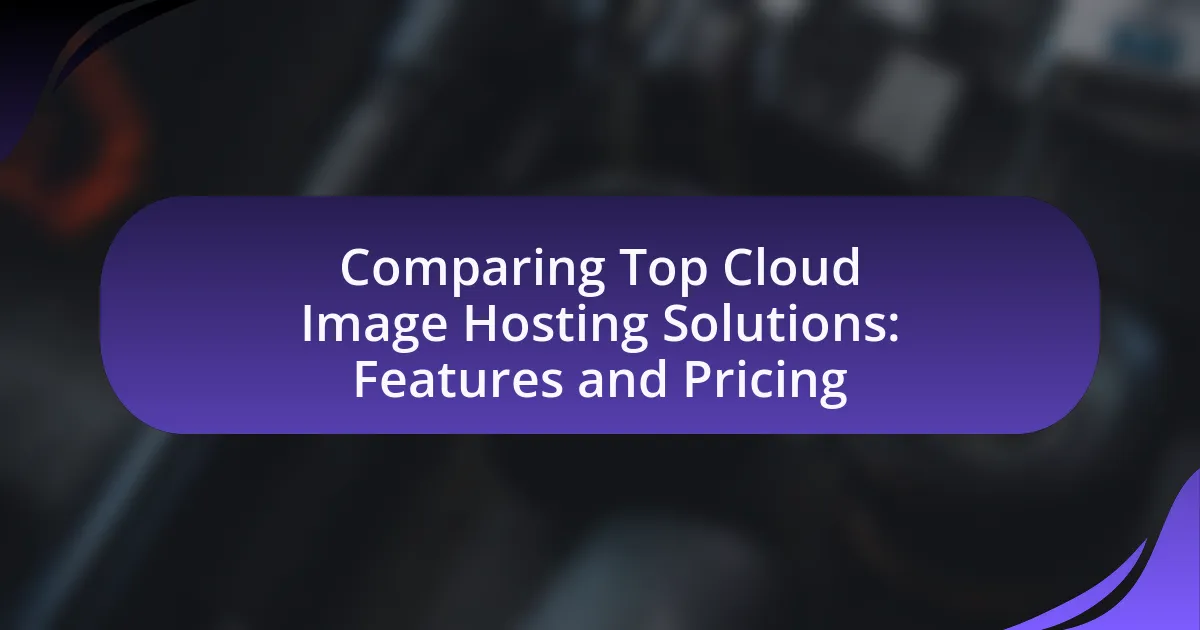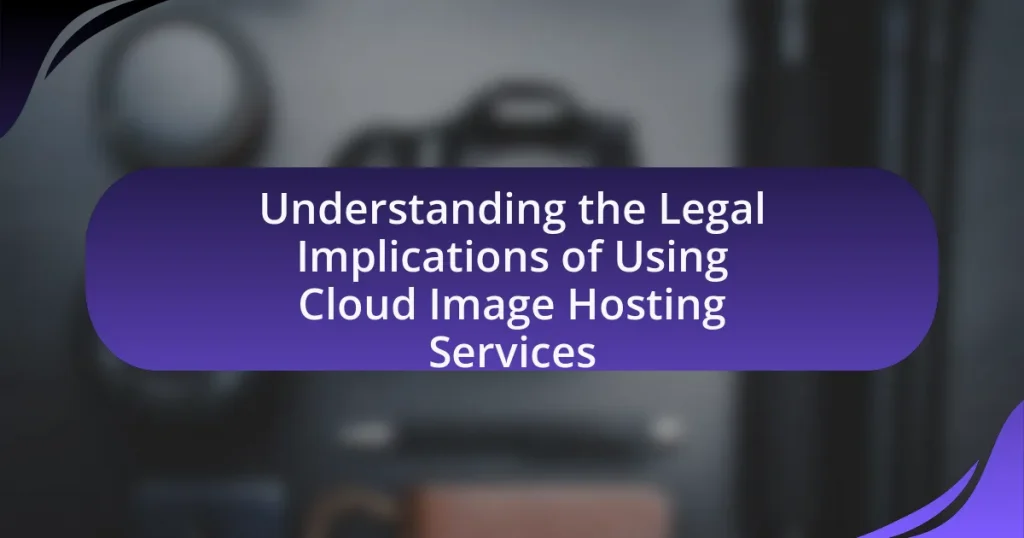The article focuses on comparing top cloud image hosting solutions, specifically Amazon S3, Google Cloud Storage, and Microsoft Azure Blob Storage. It outlines the key features that distinguish cloud hosting from traditional image hosting, including scalability, accessibility, and security. The discussion includes factors to consider when evaluating these solutions, such as storage capacity, pricing models, and integration capabilities. Additionally, it highlights the growing popularity of cloud image hosting due to its cost-effectiveness and ease of use, while also addressing best practices for selecting the most suitable solution based on individual needs and potential pitfalls to avoid.
What are the Top Cloud Image Hosting Solutions?

The top cloud image hosting solutions include Amazon S3, Google Cloud Storage, and Microsoft Azure Blob Storage. Amazon S3 offers scalable storage with high durability and availability, making it suitable for businesses of all sizes. Google Cloud Storage provides seamless integration with other Google services and strong security features. Microsoft Azure Blob Storage is known for its flexibility and robust performance, catering to various storage needs. These solutions are widely recognized for their reliability, scalability, and comprehensive features, making them leaders in the cloud image hosting market.
How do these solutions differ from traditional image hosting?
Cloud image hosting solutions differ from traditional image hosting primarily in their scalability and accessibility. Traditional image hosting typically offers limited storage and bandwidth, often requiring manual management of files, while cloud solutions provide virtually unlimited storage, automatic backups, and global accessibility through the internet. Additionally, cloud image hosting often includes advanced features such as content delivery networks (CDNs) for faster loading times, automated image optimization, and integration with various applications, which are not standard in traditional hosting. These differences enhance user experience and operational efficiency, making cloud solutions more suitable for modern web applications and businesses.
What are the key features that define cloud image hosting solutions?
Cloud image hosting solutions are defined by features such as scalability, accessibility, security, and integration capabilities. Scalability allows users to store and manage large volumes of images without performance degradation, accommodating growth in data needs. Accessibility ensures that images can be retrieved and shared easily from any device with internet connectivity, enhancing user experience. Security features, including encryption and access controls, protect images from unauthorized access and data breaches. Integration capabilities with other applications and services streamline workflows, enabling users to manage images alongside other digital assets efficiently. These features collectively enhance the functionality and usability of cloud image hosting solutions, making them essential for businesses and individuals alike.
Why is cloud image hosting becoming increasingly popular?
Cloud image hosting is becoming increasingly popular due to its scalability, cost-effectiveness, and ease of access. Businesses and individuals can store and manage large volumes of images without the need for extensive local infrastructure, which reduces overhead costs. According to a report by MarketsandMarkets, the cloud storage market is projected to grow from $50.1 billion in 2020 to $137.3 billion by 2025, indicating a significant shift towards cloud solutions. Additionally, cloud image hosting services often provide features such as automatic backups, enhanced security, and global accessibility, making them attractive options for users seeking reliable and efficient image management solutions.
What factors should be considered when comparing cloud image hosting solutions?
When comparing cloud image hosting solutions, key factors to consider include storage capacity, pricing structure, image quality, scalability, security features, and ease of integration. Storage capacity determines how many images can be stored, while pricing structure affects overall costs based on usage. Image quality is crucial for maintaining visual integrity, and scalability ensures the solution can grow with your needs. Security features protect sensitive data, and ease of integration with existing systems enhances usability. These factors collectively influence the effectiveness and suitability of a cloud image hosting solution for specific requirements.
How important is storage capacity in choosing a cloud image hosting solution?
Storage capacity is crucial when selecting a cloud image hosting solution, as it directly impacts the amount of data that can be stored and accessed. A higher storage capacity allows users to upload and manage a larger number of images without the risk of running out of space, which is essential for businesses and individuals with extensive image libraries. For instance, many cloud hosting providers offer tiered storage plans, where the cost and features vary significantly based on the allocated storage, highlighting the importance of this factor in decision-making. Additionally, according to a report by Statista, the global demand for cloud storage is projected to grow, indicating that users increasingly prioritize storage capacity in their hosting solutions.
What role does scalability play in cloud image hosting?
Scalability is crucial in cloud image hosting as it allows services to efficiently manage varying amounts of image data and user demand. This flexibility ensures that as the volume of images increases or decreases, the hosting solution can adjust resources accordingly without compromising performance. For instance, a cloud image hosting provider can automatically allocate additional storage and bandwidth during peak usage times, such as during a product launch or marketing campaign, ensuring seamless access for users. This capability is supported by the architecture of cloud services, which typically utilize distributed systems that can scale horizontally, meaning they can add more servers to handle increased loads.
What are the Key Features of Leading Cloud Image Hosting Solutions?

Key features of leading cloud image hosting solutions include scalability, security, ease of integration, and performance optimization. Scalability allows users to store and manage large volumes of images without compromising speed or accessibility. Security features, such as encryption and access controls, protect sensitive data from unauthorized access. Ease of integration with various platforms and APIs enables seamless workflows for developers and businesses. Performance optimization techniques, including content delivery networks (CDNs) and image compression, enhance loading times and user experience. These features are essential for businesses looking to efficiently manage their image assets in a cloud environment.
How do user interfaces vary among different cloud image hosting platforms?
User interfaces among different cloud image hosting platforms vary significantly in design, functionality, and user experience. For instance, platforms like Google Photos emphasize simplicity and ease of navigation, featuring a clean layout with intuitive search capabilities and automatic organization of images. In contrast, platforms such as Flickr offer a more complex interface with extensive customization options, allowing users to create albums and engage with a community through comments and groups. Additionally, services like Dropbox focus on file management, presenting a straightforward interface that integrates image hosting with broader file storage functionalities. These differences reflect the platforms’ target audiences and primary use cases, influencing how users interact with their images and manage their collections.
What are the usability features that enhance user experience?
Usability features that enhance user experience include intuitive navigation, responsive design, and efficient search functionality. Intuitive navigation allows users to easily find what they need without confusion, which is supported by studies showing that 94% of users cite easy navigation as a key factor in their satisfaction. Responsive design ensures that the platform functions well across various devices, enhancing accessibility; research indicates that 57% of users will not recommend a business with a poorly designed mobile site. Efficient search functionality enables users to quickly locate specific images or features, with data revealing that 30% of users prefer using search over browsing. These features collectively contribute to a seamless and satisfying user experience in cloud image hosting solutions.
How do integrations with other tools and services impact functionality?
Integrations with other tools and services enhance functionality by enabling seamless data exchange and process automation. For instance, cloud image hosting solutions that integrate with content management systems allow users to automatically upload and manage images, improving workflow efficiency. Additionally, integrations with analytics tools provide insights into image performance, helping users optimize their content strategy. Research indicates that companies leveraging integrations experience up to a 30% increase in productivity due to streamlined operations and reduced manual tasks.
What security measures are typically offered by cloud image hosting solutions?
Cloud image hosting solutions typically offer security measures such as data encryption, access controls, and regular backups. Data encryption protects images both in transit and at rest, ensuring that unauthorized users cannot access sensitive information. Access controls allow users to set permissions for who can view or edit images, enhancing security by limiting exposure. Regular backups safeguard against data loss, providing a recovery option in case of accidental deletion or system failure. These measures are essential for maintaining the integrity and confidentiality of hosted images.
How do these security features protect user data?
Security features protect user data by implementing encryption, access controls, and regular security audits. Encryption ensures that data is transformed into a secure format that is unreadable without the appropriate decryption key, safeguarding it from unauthorized access during transmission and storage. Access controls restrict data access to authorized users only, minimizing the risk of data breaches. Regular security audits identify vulnerabilities and ensure compliance with security standards, further enhancing data protection. These measures collectively create a robust security framework that significantly reduces the likelihood of data exposure or loss.
What compliance standards do leading solutions adhere to?
Leading cloud image hosting solutions adhere to compliance standards such as GDPR, HIPAA, ISO 27001, and SOC 2. These standards ensure that data protection, privacy, and security measures are in place. For instance, GDPR mandates strict data handling and privacy protocols for users in the European Union, while HIPAA sets requirements for protecting sensitive health information in the United States. ISO 27001 provides a framework for establishing, implementing, and maintaining an information security management system, and SOC 2 focuses on the controls related to security, availability, processing integrity, confidentiality, and privacy of customer data.
How do Pricing Models Work for Cloud Image Hosting Solutions?

Pricing models for cloud image hosting solutions typically operate on a tiered structure based on usage metrics such as storage space, bandwidth, and the number of images hosted. These models allow users to select a plan that aligns with their specific needs, often offering a pay-as-you-go option for flexibility. For instance, many providers charge a monthly fee that increases with additional storage or data transfer, while others may offer flat-rate pricing for a set amount of resources.
Additionally, some cloud image hosting services implement a freemium model, providing basic features for free and charging for premium functionalities like advanced analytics or enhanced security. This approach is supported by market data indicating that 70% of users prefer scalable pricing options that can adapt to their growing requirements. Overall, the pricing models are designed to accommodate a wide range of users, from individuals to large enterprises, ensuring that costs are proportional to the level of service utilized.
What are the common pricing structures for cloud image hosting services?
Common pricing structures for cloud image hosting services include pay-as-you-go, subscription-based, and tiered pricing models. Pay-as-you-go allows users to pay only for the storage and bandwidth they actually use, making it flexible for varying needs. Subscription-based models typically offer a fixed monthly or annual fee for a set amount of storage and features, providing predictability in costs. Tiered pricing structures offer different levels of service at varying price points, allowing users to choose a plan that best fits their requirements. These models are prevalent among major providers like Amazon S3, Google Cloud Storage, and Dropbox, which cater to diverse user needs and budgets.
How do subscription plans compare to pay-as-you-go models?
Subscription plans typically offer a fixed monthly or annual fee for a set amount of services, while pay-as-you-go models charge users based on actual usage. Subscription plans provide predictable costs and often include additional features or benefits, making them suitable for users with consistent needs. In contrast, pay-as-you-go models offer flexibility and can be more cost-effective for users with variable usage patterns, as they only pay for what they consume. According to a study by Gartner, organizations that adopt subscription models can reduce costs by up to 30% compared to traditional pay-as-you-go pricing, highlighting the financial advantages of subscription plans for regular users.
What additional costs should users be aware of?
Users should be aware of potential additional costs such as storage fees, bandwidth overages, and premium features. Many cloud image hosting solutions offer a base price that covers a certain amount of storage and bandwidth, but exceeding these limits can incur extra charges. For instance, if a user exceeds the allocated bandwidth, they may face fees that can range from a few cents to several dollars per gigabyte, depending on the provider. Additionally, some platforms charge for advanced features like enhanced security, custom domains, or API access, which can significantly increase overall expenses.
How can users determine the best value for their needs?
Users can determine the best value for their needs by evaluating the features, pricing, and performance of different cloud image hosting solutions. By comparing specific attributes such as storage capacity, bandwidth limits, ease of use, customer support, and integration capabilities, users can identify which service aligns with their requirements. Additionally, analyzing user reviews and case studies can provide insights into real-world performance and satisfaction, further aiding in the decision-making process.
What factors influence the overall cost-effectiveness of a solution?
The overall cost-effectiveness of a solution is influenced by factors such as initial investment, operational costs, scalability, and the quality of service provided. Initial investment refers to the upfront costs associated with implementing the solution, which can vary significantly among different cloud image hosting services. Operational costs include ongoing expenses like storage fees, bandwidth usage, and maintenance, which impact long-term affordability. Scalability is crucial as it determines how easily a solution can adapt to changing demands without incurring excessive costs. Finally, the quality of service, including uptime, support, and performance, affects user satisfaction and can lead to additional costs if service levels are inadequate. These factors collectively determine the value derived from the investment in a solution, making them essential for evaluating cost-effectiveness.
How do discounts and promotions affect pricing decisions?
Discounts and promotions significantly influence pricing decisions by altering perceived value and demand elasticity. When businesses implement discounts, they often aim to increase sales volume, attract new customers, or clear inventory, which can lead to a temporary reduction in profit margins. For instance, a study by the Journal of Marketing Research found that promotional pricing can increase sales by up to 30% during the promotion period. Additionally, frequent discounts may condition customers to expect lower prices, impacting their willingness to pay full price in the future. This dynamic necessitates careful consideration in pricing strategies to balance short-term sales boosts with long-term brand positioning and profitability.
What are the Best Practices for Choosing a Cloud Image Hosting Solution?
The best practices for choosing a cloud image hosting solution include evaluating storage capacity, assessing scalability, ensuring security features, and analyzing cost-effectiveness. Evaluating storage capacity is crucial as it determines how many images can be stored without additional costs; for instance, many providers offer tiered storage plans based on usage. Assessing scalability is important to accommodate future growth, as a solution should easily adapt to increasing storage needs without significant downtime or migration issues. Ensuring security features, such as encryption and access controls, protects sensitive images from unauthorized access, which is vital for compliance with regulations like GDPR. Analyzing cost-effectiveness involves comparing pricing models, including pay-as-you-go versus subscription plans, to find a solution that aligns with budget constraints while meeting performance requirements. These practices help in selecting a reliable and efficient cloud image hosting solution.
How can users assess their specific needs before selecting a solution?
Users can assess their specific needs before selecting a solution by identifying their requirements regarding storage capacity, accessibility, and integration capabilities. This involves evaluating the volume of images to be hosted, the frequency of access needed, and whether the solution must integrate with existing tools or platforms. For instance, a user with a large volume of images may prioritize solutions that offer scalable storage options, while a user needing frequent access might focus on platforms with robust mobile and web interfaces. Additionally, users should consider their budget constraints and the pricing models of different solutions, as this can significantly impact their choice.
What common pitfalls should users avoid when comparing options?
Users should avoid the pitfall of focusing solely on price when comparing cloud image hosting solutions. This narrow focus can lead to overlooking essential features such as storage capacity, bandwidth limits, and customer support quality. For instance, a cheaper option may offer limited storage or poor performance, ultimately costing more in the long run due to additional fees or reduced efficiency. Additionally, users should be cautious of not thoroughly reviewing user feedback and expert reviews, as these insights can reveal potential issues that are not immediately apparent in marketing materials.



